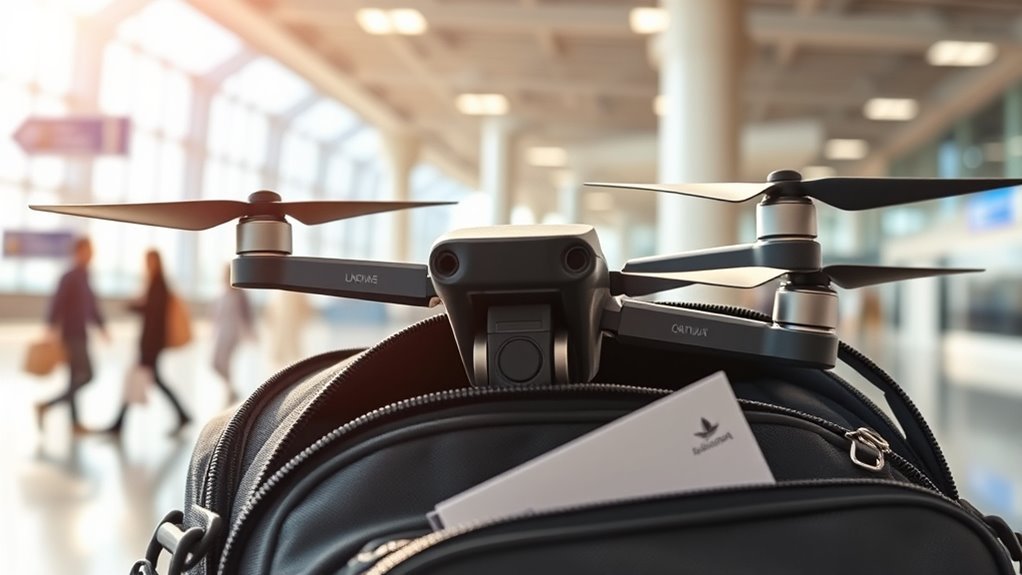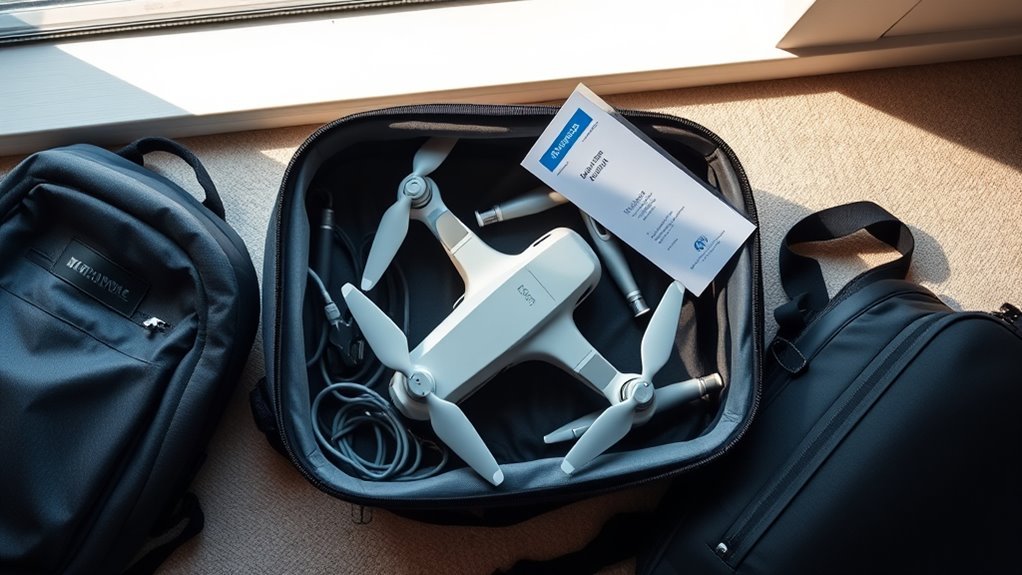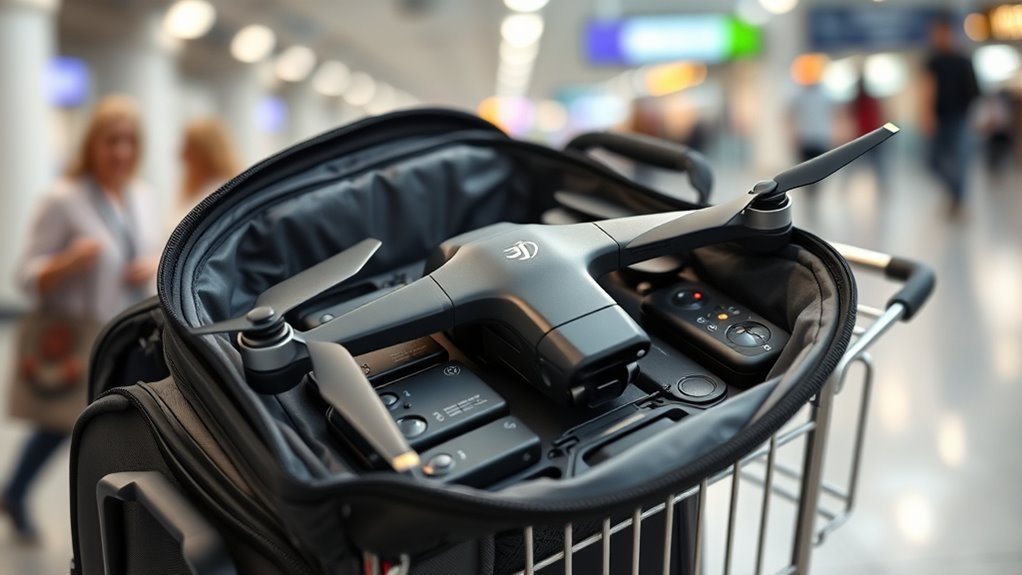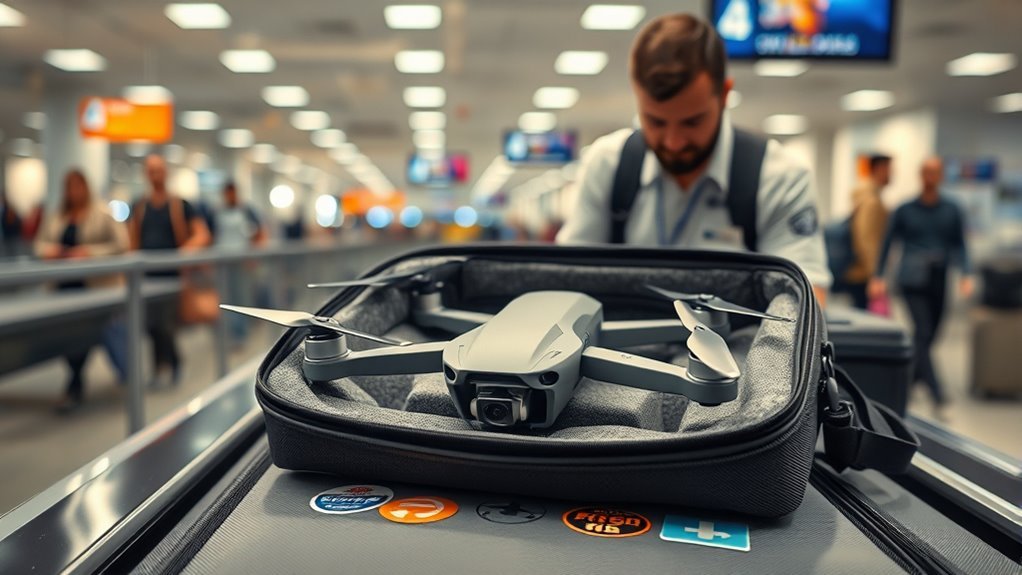To bring your drone on an airplane, first check your airline’s policies on size and weight. Always carry your drone in your carry-on luggage, as TSA recommends this to prevent damage. Make certain to pack batteries separately, keeping them under 100 watt-hours in a fireproof bag. Familiarize yourself with destination drone laws, as regulations can vary. If you’re looking for tips to guarantee a hassle-free travel experience, there’s more useful information waiting for you.
Understanding Airline Policies

Before you pack your drone for air travel, it’s essential to understand the specific policies of the airline you’re flying with. Different airlines have varying restrictions based on drone size, and some may even prohibit certain models entirely. Check the airline’s website for details on drone dimensions and weight allowances to avoid surprises at the airport. Additionally, be mindful of any battery regulations, as lithium-ion batteries often have strict limits. Knowing these airline restrictions will help you plan accordingly, ensuring your drone travels safely and legally. This way, you can enjoy the freedom of capturing breathtaking aerial footage without facing unexpected challenges during your journey. Always prepare in advance to make your travel experience as smooth as possible.
TSA Guidelines for Traveling With Drones

When traveling with your drone, it’s crucial to understand the TSA guidelines that govern its transport. You’ll need to take into account whether to pack it in your carry-on or checked baggage, as well as follow specific battery regulations. Properly packing your drone can prevent damage and guarantee compliance with security procedures.
Carry-on vs. Checked Baggage
While it might be tempting to pack your drone in checked baggage for convenience, the TSA guidelines recommend carrying it on instead. Keeping your drone in your carry-on allows you to monitor its safety and avoid potential damage during transit. Checked baggage can face rough handling, which could harm your equipment. Additionally, there are specific carry-on restrictions regarding the size and weight of your drone; make sure it fits within your airline’s requirements. By bringing it on board, you also guarantee compliance with any airline policies, reducing the risk of delays or confiscation. Ultimately, carrying your drone with you not only protects your investment but also gives you peace of mind as you travel.
Battery Regulations Explained
Understanding battery regulations is vital for traveling with your drone, especially since most drones rely on lithium polymer (LiPo) batteries. The TSA imposes strict lithium battery limits, typically allowing batteries up to 100 watt-hours (Wh) in carry-on luggage. If your battery exceeds this limit, you might be required to seek special permission or leave it behind. Additionally, be aware of voltage restrictions; batteries over 160 volts are prohibited altogether. It’s important to check the specific capacity of your batteries and guarantee they’re properly stored in a fireproof bag. Always keep your batteries in your carry-on, as checked baggage isn’t the safest choice. Familiarizing yourself with these regulations can help you maintain your freedom to fly while staying compliant.
Packing Tips for Drones
After ensuring your drone batteries comply with TSA regulations, the next step is packing your drone for air travel. Use a sturdy backpack or case that fits your drone and its accessories securely. Remember to separate the batteries and carry them in your carry-on. Here’s a quick packing guide:
| Item | Packing Method | Location |
|---|---|---|
| Drone | Securely in case | Carry-on bag |
| Batteries | In original packaging | Carry-on bag |
| Drone Accessories | Smaller pouches | Carry-on bag |
Double-check that all items are easily accessible for security checks. With these travel essentials organized, you’ll be ready to explore the skies without hassle. Safe travels!
Packing Your Drone for Air Travel

When packing your drone for air travel, it’s essential to understand battery regulations and safety precautions. You’ll need to guarantee your batteries are compliant with airline policies and stored properly to avoid potential hazards. Additionally, selecting the right protective case can safeguard your drone during transit and make your journey smoother.
Battery Regulations and Safety
Since lithium batteries power most drones, it’s crucial to know the regulations governing their transport on airplanes. Airlines typically allow lithium-ion batteries under 100 watt-hours in your carry-on luggage, but anything above that usually requires special permission. Always check the specific battery types allowed by your airline. For safety precautions, keep batteries in their original packaging or use protective cases to prevent short-circuiting. Make sure terminals are covered and avoid packing loose batteries. If you’re carrying multiple batteries, verify they’re individually secured to minimize risk. Adhering to these guidelines not only guarantees compliance but also safeguards your equipment and fellow travelers, allowing you to enjoy the freedom of aerial exploration without worry.
Protective Case Options
Choosing the right protective case for your drone is essential for safe air travel. A hard shell case provides the durability needed to withstand the rigors of travel, protecting your drone from bumps and drops. Look for options that include custom foam inserts, designed to cradle your drone and accessories securely. This guarantees everything stays in place, minimizing movement during transit. Make sure the case meets airline size regulations, as this can prevent unnecessary hassles at the airport. Additionally, consider a case with a comfortable handle or wheels, allowing for easier transport through busy terminals. By investing in a quality protective case, you can enjoy the freedom of traveling with your drone without worrying about damage.
Battery Regulations and Safety
Understanding battery regulations and safety is essential for anyone planning to travel with a drone. Most airlines adhere to strict lithium regulations due to the potential hazards of lithium batteries. Typically, batteries over 100 watt-hours aren’t allowed in carry-on or checked baggage, so you’ll need to check your drone’s specifications. Always carry spare batteries in your carry-on, as they must be accessible for inspection. Verify each battery’s terminals are protected to prevent short-circuiting, which can pose serious safety risks. Familiarize yourself with the specific airline’s policies regarding battery safety, as they can vary. Staying informed not only helps verify a smooth travel experience but also allows you to enjoy your drone’s freedom once you reach your destination.
Carry-On vs. Checked Baggage
When planning to bring your drone on an airplane, it’s essential to contemplate whether to pack it in your carry-on or checked baggage. Each option has its pros and cons, especially regarding safety and convenience. Here’s a quick breakdown:
When traveling with your drone, consider the benefits of carry-on versus checked baggage for safety and convenience.
- Carry-On Regulations: Most airlines allow drones in carry-on luggage, but check specific regulations.
- Safety: Keeping your drone with you minimizes the risk of damage or theft during travel.
- Battery Rules: Lithium batteries are usually restricted in checked baggage, so carry them on instead.
- Convenience: Having your drone handy lets you easily access it for potential inspections at security.
Weigh these factors carefully to decide the best way to travel with your drone and enjoy your freedom.
International Travel Considerations
Traveling internationally with your drone requires careful consideration of various regulations and potential restrictions that differ by country. Before you pack your drone, familiarize yourself with the specific international drone laws of your destination. Some countries may have strict rules about flying drones, while others might require permits or registration. Additionally, you should understand the customs regulations regarding bringing electronic devices across borders, as you might face additional scrutiny at customs. To avoid complications, check the airline’s policies on traveling with drones, and guarantee you have all necessary documentation. By being informed and prepared, you can enjoy the freedom of capturing stunning aerial views without facing legal hurdles during your travels.
Destination Drone Laws and Regulations
Before you take off with your drone, it’s important to know the specific laws and regulations of your destination, as they can vary widely. Understanding local regulations can help you avoid fines or confiscation. Here are four key points to keep in mind:
Before flying your drone, ensure you understand local laws to avoid fines and ensure a smooth experience.
- Research Local Drone Laws: Familiarize yourself with the drone laws specific to your destination.
- Check for No-Fly Zones: Identify areas where flying your drone is prohibited, such as near airports or government buildings.
- Obtain Necessary Permits: Some locations may require permits for drone use, especially for commercial purposes.
- Respect Privacy Laws: Always be aware of local privacy regulations to avoid infringing on others’ rights.
Tips for a Smooth Travel Experience
To guarantee a smooth travel experience with your drone, it’s essential to prepare well in advance. Start by checking your airline’s specific rules regarding drones. Make sure your drone’s battery is properly stored and meets airline regulations. Consider getting drone insurance; it can protect you from unexpected mishaps. Additionally, secure travel insurance to cover any potential damage during your journey or while using your drone. Pack your drone in a sturdy, padded case to prevent damage. Arrive early at the airport to navigate security checks without stress. Keep your drone accessible for inspection, and be ready to explain its purpose if questioned. With these steps, you’ll enhance your travel experience and maintain the freedom to fly your drone at your destination.
Frequently Asked Questions
Can I Fly My Drone at the Airport?
You can’t fly your drone at the airport due to strict airport regulations and drone security measures. Always check local laws before attempting to operate near airports, as violations can lead to severe penalties.
What if My Drone Gets Damaged During Travel?
If your drone gets damaged during travel, it’s essential you’ve got drone insurance. Taking travel precautions, like proper packaging, can minimize risks. Remember, freedom comes with responsibility—protect your gear for the adventures ahead.
How Do I Register My Drone for Air Travel?
To register your drone, follow the drone registration process outlined by the FAA. Familiarize yourself with air travel regulations to guarantee compliance. This way, you can enjoy your freedom while flying responsibly and legally.
Are There Restrictions for Flying Drones in Foreign Countries?
Imagine soaring freely, but remember: drone regulations vary widely across countries. For international travel, research local laws before you go. Ignoring them could lead to hefty fines or confiscation. Stay informed, and enjoy your adventures!
Can I Bring Extra Drone Parts on the Plane?
You can bring extra drone parts, but check drone battery regulations and spare parts guidelines. Verify they comply with airline policies and local laws to enjoy your drone experience without unexpected hassles during travel.

